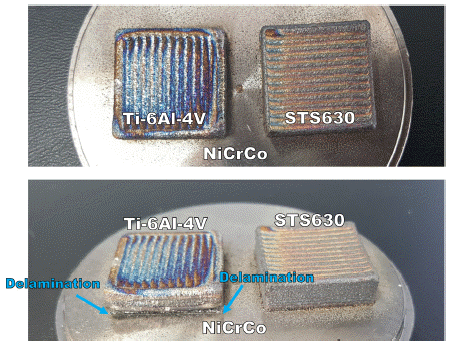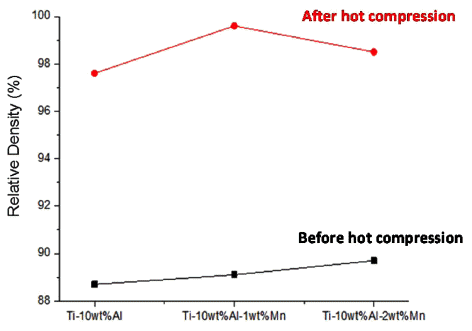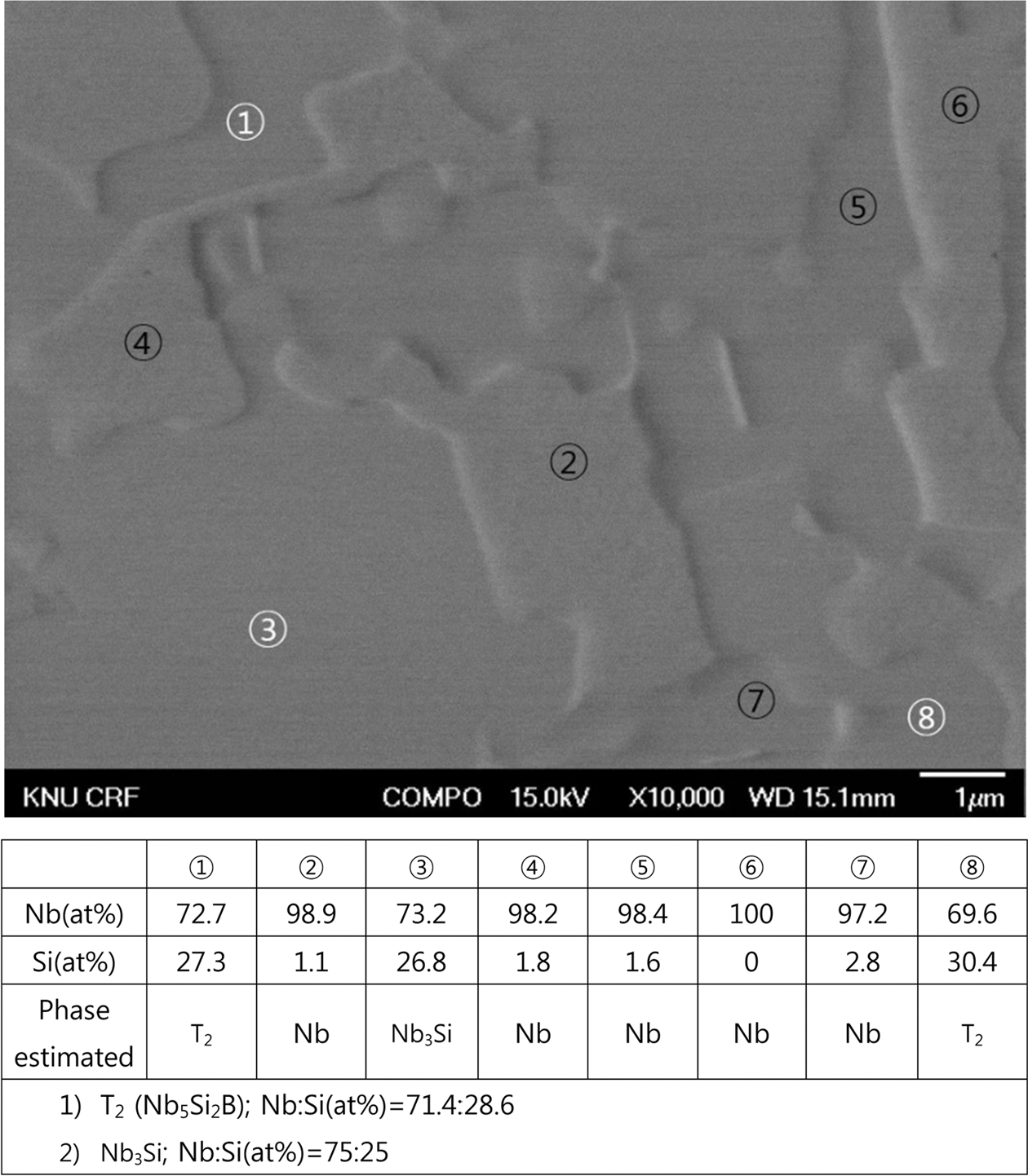Search
- Page Path
- HOME > Search
- [Korean]
- Joint Properties of Stainless Steel and Titanium Alloys Additive Manufactured on Medium Entropy Alloys
- Chan Woong Park, Nana Kwabena Adomako, Min Gyu Lee, Jeoung Han Kim
- J Korean Powder Metall Inst. 2019;26(4):319-326. Published online August 1, 2019
- DOI: https://doi.org/10.4150/KPMI.2019.26.4.319

- 552 View
- 5 Download
-
 Abstract
Abstract
 PDF
PDF Additive manufacturing (AM) is a highly innovative method for joining dissimilar materials for industrial applications. In the present work, AM of STS630 and Ti-6Al-4V powder alloys on medium entropy alloys (MEAs) NiCrCo and NiCrCoMn is studied. The STS630 and Ti64 powders are deposited on the MEAs. Joint delamination and cracks are observed after the deposition of Ti64 on the MEAs, whereas the deposition of STS630 on the MEAs is successful, without any cracks and joint delamination. The microstructure around the fusion zone interface is characterized by scanning electron microscopy and X-ray diffraction. Intermetallic compounds are formed at the interfacial regions of MEA-Ti64 samples. In addition, Vicker’s hardness value increased dramatically at the joint interface between MEAs and Ti-6Al-4V compared to that between MEAs and STS630. This result is attributed to the brittle nature of the joint, which can lead to a decrease in the joint strength.
- [Korean]
- Effect of Mn Addition on Sintering Properties of Ti-10wt.%Al-xMn Powder Alloy
- Gi-Seung Shin, Yong-Taek Hyun, Nho-Kwang Park, Yong-Ho Park, Dong-Geun Lee
- J Korean Powder Metall Inst. 2016;24(3):235-241. Published online June 1, 2016
- DOI: https://doi.org/10.4150/KPMI.2017.24.3.235

- 664 View
- 2 Download
- 2 Citations
-
 Abstract
Abstract
 PDF
PDF Titanium alloys have high specific strength, excellent corrosion and wear resistance, as well as high heatresistant strength compared to conventional steel materials. As intermetallic compounds based on Ti, TiAl alloys are becoming increasingly popular in the aerospace field because these alloys have low density and high creep properties. In spite of those advantages, the low ductility at room temperature and difficult machining performance of TiAl and Ti3Al materials has limited their potential applications. Titanium powder can be used in such cases for weight and cost reduction. Herein, pre-forms of Ti-Al-xMn powder alloys are fabricated by compression forming. In this process, Ti powder is added to Al and Mn powders and compressed, and the resulting mixture is subjected to various sintering temperature and holding times. The density of the powder-sintered specimens is measured and evaluated by correlation with phase formation, Mn addition, Kirkendall void, etc. Strong Al-Mn reactions can restrain Kirkendall void formation in Ti-Al-xMn powder alloys and result in increased density of the powder alloys. The effect of Al-Mn reactions and microstructural changes as well as Mn addition on the high-temperature compression properties are also analyzed for the Ti-Al-xMn powder alloys.
-
Citations
Citations to this article as recorded by- Lattice Deformation and Improvement Oxidation Resistance of Ti-6Al-4V Alloy Powders Prepared by Hydrogen Added Argon Heat Treatment
Gye-Hoon Cho, Jung-Min Oh, Jae-Won Lim
Journal of Korean Powder Metallurgy Institute.2019; 26(2): 126. CrossRef - Effect of post heat treatment on fatigue properties of EBM 3D-printed Ti-6Al-4V alloy
Young-Sin Choi, Ji-Hoon Jang, Gun-Hee Kim, Chang-Woo Lee, Hwi-Jun Kim, Dong-Geun Lee
Journal of Korean Powder Metallurgy Institute.2018; 25(4): 340. CrossRef
- Lattice Deformation and Improvement Oxidation Resistance of Ti-6Al-4V Alloy Powders Prepared by Hydrogen Added Argon Heat Treatment
- [Korean]
- Microstructure Characterization of Nb-Si-B alloys Prepared by Spark Plasma Sintering Process
- Sang-Hwan Kim, Nam-Woo Kim, Young-Keun Jeong, Sung-Tag Oh, Young Do Kim, Seong Lee, Myung Jin Suk
- J Korean Powder Metall Inst. 2015;22(6):426-431. Published online December 1, 2015
- DOI: https://doi.org/10.4150/KPMI.2015.22.6.426

- 754 View
- 3 Download
- 5 Citations
-
 Abstract
Abstract
 PDF
PDF Microstructural examination of the Nb-Si-B alloys at Nb-rich compositions is performed. The Nb-rich corner of the Nb-Si-B system is favorable in that the constituent phases are Nb (ductile and tough phase with high melting temperature) and T2 phase (very hard intermetallic compound with favorable oxidation resistance) which are good combination for high temperature structural materials. The samples containing compositions near Nb-rich corner of the Nb- Si-B ternary system are prepared by spark plasma sintering (SPS) process using T2 and Nb powders. T2 bulk phase is made in arc furnace by melting the Nb slug and the Si-B powder compact. The T2 bulk phase was subsequently ballmilled to powders. SPS is performed at 1300°C and 1400°C, depending on the composition, under 30 MPa for 600s, to produce disc-shaped specimen with 15 mm in diameter and 3 mm high. Hardness tests (Rockwell A-scale and micro Vickers) are carried out to estimate the mechanical property.
-
Citations
Citations to this article as recorded by- Fabrication of Nb-Si-B Alloys Using the Pulverized Nb-T2 Alloy Powder
Min-Ho Cho, Sung-Jun Kim, Hyun-Ji Kang, Sung-Tag Oh, Young Do Kim, Seong Lee, Myung Jin Suk
Journal of Korean Powder Metallurgy Institute.2019; 26(4): 299. CrossRef - Mechanical properties of Mo-Nb-Si-B quaternary alloy fabricated by powder metallurgical method
Jong Min Byun, Su-Ryong Bang, Se Hoon Kim, Won June Choi, Young Do Kim
International Journal of Refractory Metals and Hard Materials.2017; 65: 14. CrossRef - Mechanical properties of Mo-Si-B alloys fabricated by using core-shell powder with dispersion of yttria nanoparticles
Jong Min Byun, Su-Ryong Bang, Won June Choi, Min Sang Kim, Goo Won Noh, Young Do Kim
Metals and Materials International.2017; 23(1): 170. CrossRef - Fabrication of Ta2O5 Dispersion-Strengthened Mo-Si-B Alloy by Powder Metallurgical Method
Jong Min Byun, Won June Choi, Su-Ryong Bang, Chun Woong Park, Young Do Kim
JOM.2017; 69(4): 683. CrossRef - Rapid consolidation of nanostuctured WC-FeAl3 by pulsed current activated heating and its mechanical properties
In-Jin Shon, Seok-Jae Lee
International Journal of Refractory Metals and Hard Materials.2017; 65: 69. CrossRef
- Fabrication of Nb-Si-B Alloys Using the Pulverized Nb-T2 Alloy Powder
TOP
 KPMI
KPMI


 First
First Prev
Prev


